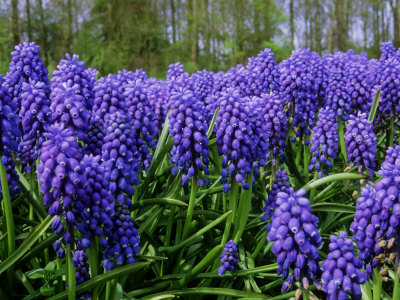Muscari, better known as grape hyacinth isn’t a hyacinth at all, although it does resemble a miniature one. Find a permanent spot for muscari in the yard, because much like a tree, it will occupy the spot for decades. Fortunately, it doesn’t spread easily so you don’t have to worry about it overtaking a flower bed or other area where it’s been planted.
Muscari is a very short plant with grass-like leaves. They flower very early in the spring and are done blooming about the time you start cutting your grass. This makes muscari a good bulb to naturalize in a yard. Toss a handful of muscari out into the yard (it’s okay to toss a few under a deciduous tree) and plant them where they land. Or, plant them along the front edge of a bulb garden, perennial flower bed, or rock garden.
I’ve always planted the blue muscari; however, they also come in white and purple. With the exception of an occasional rabbit, rodents and deer aren’t interested in muscari, so plant as many as you want without worrying about them becoming food for the critters.

When to plant:
Plant in fall after the ground has cooled, which means late September to early October in the northern states (zone 4), and into November in the southern states (zones 6-8). Find your climate zone using your zip code.
Where to plant:
Plant in full sun to partial shade (they prefer partial shade, particularly in the warmer parts of the country) in well drained soil. Amend poor soil with compost.

Planting depth:
Plant muscari about 2″ deep but don’t worry if you get it wrong, the bulb will right itself if planted upside down or sideways.
Spacing:
Muscarican be planted 3-4 inches apart (further apart for naturalizing).
How to Plant:
I’m always looking for yard tools that can help me spend less time working and more time enjoying my landscape, and the ProPlugger 5-IN-1 Planting Tool fits that bill perfectly. Because muscari bulbs are small, you can actually plant them from a standing position. Here’s how:
Feeding:
When the leaf tips begin to poke out of the ground, apply a 5-10-10 fertilizer. About the time of flowering, top dress with a 0-0-10 or 0-0-50 fertilizer. Fertilize in the spring of each year with a 5-10-10 fertilizer or all purpose fertilizer used for feeding flowers. Mulching around the plants with aged compost or well rotted manure will achieve the same effect as a light feeding of fertilizer.
Disease and pests affecting muscari:
Rabbits munching on the leaves is the most commonly reported problem. Otherwise, they’re pretty problem free as long as they are spaced properly and grown in nutrient-rich soil.
Hardiness zone:
Muscari is hardy in zones 5-8. I’ve also been able to grow them successfully in my zone 4 garden.
Popular varieties of muscari:
The two most common species in cultivation are the Muscari armeniacum (typically blue in color) and Muscari botryoides var. alba (typically white in color). Muscari latifolium, or bi-color grape hyacinth is an interesting variety. It blooms a deep violet towards the bottom of the flower head and a light blue up top.
Neil Moran is a horticulturist and author of three books on gardening. He is also the creator and author of the garden blog North Country Gardener.
Additional resources for muscari:
Be sure to check out the helpful information on our website, including other uses for the ProPlugger including:

